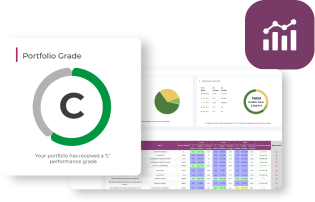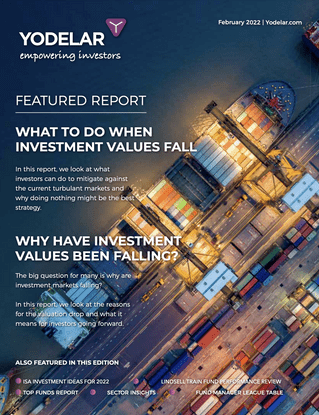- On a daily basis we come across investors significantly overweight in North America, ignoring asset allocation and diversification
- Despite many investor portfolios being overweight in the North America sector, it is important to note that since the DotCom bubble burst the US sector has ranked only 11th out of the 20 main sectors for growth
- U.S. National debt is increasing by nearly $8.5 billion per day, a pace that has seen it almost double in just 10 years - rising from $17.7 trillion in August 2014 to $35.6 trillion in August 2024. Analysts have serious concerns that a U.S. market crash is looming
- Poor portfolio diversification is now the most dangerous threat to UK investors
UK Investors have continued to increase their portfolios weighting in North American equity funds as the region has been one of the biggest drivers of growth in recent years. However, this heavy reliance on North America has led to an over-concentration that could now pose significant risks to investment portfolios.
There is growing consensus among market analysts that the challenges faced by the U.S. market has increased the risk of a market crash - with so many UK investors overweight in North American equities this is a threat that must not be overlooked.
In this article we identify key concerns that investors must consider to protect against the growing risks of maintaining an investment strategy that is over reliant on North American markets to drive their portfolio growth.
Is a large percentage of your portfolio over exposed to North America? Click here to book a no obligation call with our advice team to discuss possible options for diversification.
Breaking the North American Dependency
For many years North American funds have been among the most prominent holdings in the portfolios of UK investors. This is not surprising as the U.S. has driven global economic growth, powered by a relentless surge of tech giants like Apple, Amazon, and Microsoft. This growth has translated into substantial gains for investors, making the U.S. market a favoured choice.
However, this success has created a comfort zone that many UK investors find difficult to leave. The familiarity and strong historical performance of these markets make them appear safe and reliable. But this very reliance can be a double-edged sword. While the North American markets have been incredibly rewarding, this dependence leaves portfolios vulnerable to significant risks, and the current economic landscape shows that this strategy is in need of re-evaluation, now more than anytime in recent history.
Is The U.S. Stock Market About To Crash?
There is growing concern among analysts that the U.S. stock market may be close to crashing. Many believe that risks of a crash are currently heightened compared to previous periods due to several converging risk factors. These include historically high valuations in key sectors, rising interest rates driven by efforts to combat inflation, and the increasing burden of U.S. national debt. Additionally, geopolitical tensions and economic uncertainties add to the potential for market instability.
While predicting a crash with certainty is impossible, these factors collectively suggest that the market is more vulnerable to a significant downturn than it has been in recent years. With the U.S. presidential election in November many sceptics believe that the Government has been afraid to make fiscal changes that could hamper their re-election chances and have instead chosen to continue to allow the National debt to rise at a rate of $8.5 billion per day - which simply cannot continue.
Significant changes are required to reel in National debt such as higher interest rates and large tax hikes - none of which will do markets any favours. However, there is a risk that the economic challenges faced in the U.S. could trigger a market crash before any government plan comes to pass.
The U.S. Is In $35 trillion Debt - How This Can Trigger A Stock Market Collapse
Over the past year, U.S. National debt has increased by nearly $8.5 billion per day, a pace that is simply unsustainable. This now poses significant risk to the nation's economic stability. This extreme rise has seen U.S. national debt almost double in just 10 years - rising from $17.7 trillion in August 2014 to $35.6 trillion in August 2024.
.png?width=1200&height=1300&name=oie_transparent%20(13).png)
What does this mean for investors?
Many analysts now believe that the unprecedented levels of U.S. national debt could potentially trigger a stock market crash by creating several economic vulnerabilities.
As debt grows, the government's need to service this debt will likely lead to higher interest rates, which can dampen economic growth by increasing borrowing costs for businesses and consumers. Additionally, if investors begin to lose confidence in the U.S. government's ability to manage its debt, this could lead to a sell-off in U.S. Treasury bonds, pushing interest rates even higher and destabilising financial markets. The combination of rising interest rates and economic uncertainty could lead to reduced corporate profits and investor confidence, potentially triggering a significant market downturn.
Many Investors Are Overexposed
Yodelar analyse thousands of investment portfolios via our free portfolio analysis service every year and through our analysis process it has become evidently clear that their has been a sharp rise in the proportion of investors (advised and non advised) who are ignoring risk management completely, and simply chasing recent growth sectors, such as North American equities, and tech focused funds, without applying an asset allocation model to their portfolio.
Despite the risks highlighted in this article, we found a growing number of mis-informed investors who are abandoning a diversified asset allocation model in favour of chasing returns and overloading into North America focused funds that have in recent years performed well, ignoring sectors that may not have performed as well recently, but remain critical to maintaining a balanced investment portfolio.
Whether intentional or not, over-concentration has become prevalent in many UK investor portfolios, partly due to advisers over relying on funds with a North American focus, such as many multi-asset or global equity funds. Such funds are often heavily tilted towards North America, thus lacking true global diversification.
How Investors Can Protect Against A Potential U.S. Stock Market Crash
Diversification is core to UK investors seeking to protect their portfolios against potential downturns in the U.S. stock market. A well-diversified portfolio should encompass various asset classes, spread across different sectors and geographical regions such as the UK, Europe, Asia and Emerging Markets.
The following table showcases the performance of 20 popular Investment Association sectors, tracking their annual returns since the notable market crash of 2002 sparked by the bursting of the internet bubble. Throughout the years, these sectors have witnessed both positive and negative growth trends, highlighting that despite fluctuations, most regions and sectors have ultimately delivered substantial returns over the long term.

The analysis of the 20 sectors identified that the North America sector averaged the 3rd highest growth in recent years, but since the crash of 2002 it averaged 11th, with many emerging market regions averaging better returns. This further reflects the need for diversification.

As identified in the table above, no single sector has a monopoly on top performance, which helps to illustrate the importance of diversification.
Protecting Against Market Crashes
Market crashes impact investors differently depending on their age and proximity to retirement. Those approaching or in retirement face heightened vulnerability, as their investment portfolios often represent their primary source of income.
The table below illustrates the varied nature of market crashes sin, with peak declines ranging from 9% to 57% and recovery times spanning from a single day to seven years.

Naturally, those nearing retirement face elevated risks from market downturns as they have less time to recover losses before needing to draw on their funds, which may necessitate selling investments at a loss. The 2008 Financial Crisis, for instance, saw a 57% decline in the S&P 500 and took four years to recover, highlighting the potential long-term impact on retirement plans.
While younger investors benefit from a longer time horizon to recover from market volatility, data shows that even relatively recent events like the 2020 COVID-19 crash, which recovered relatively quickly (6 months), could still significantly affect investors who needed to withdraw funds during the downturn.
While market downturns are a common occurrence in investing, diversification can play a crucial role in minimising their impact. Diversification acts as a crucial shield against the repercussions of market crashes. By spreading investments across a range of asset classes, sectors, and regions, investors can diminish the impact of downturns in any specific market sector. This strategic approach holds significant importance, especially when considering the various triggers of market crashes as illustrated in the table, ranging from technology bubbles to global health crises.
For investors, especially those approaching retirement age, grasping these historical trends and enacting suitable risk management tactics are vital for securing long-term financial stability. The data illustrated in the table underscores the diverse timelines of market rebounds, underscoring the necessity of a resilient, diversified portfolio capable of weathering economic fluctuations and offering stability during uncertain periods.
Poor Diversification
Ignoring the importance of investment diversification is, like ignoring the risks in investing. The most crucial component of investing is diversification.
A portfolio that lacks diversification is more likely to fail in reaching long-term investment objectives. The most efficient way to have a portfolio that generates suitable levels of risk and return in various market situations is by utilising diversification across asset classes.
Investors frequently believe that investing heavily in a single security or sector would maximise returns. However, this strategy can result in severe losses when market conditions change unfavourably. Too much diversification and being overly exposed to risks can also harm performance. It's important to strike a balance for the results.
It's important to recognise that no single equity style, sector, country or region consistently outperforms others. Global diversification is essential as it spreads risk across countries and currencies to mitigate the risks associated with investing in one region or country. Therefore creating portfolios with diversification is crucial for achieving success, in long-term investments.
Spreading your risk across different countries protects investors from country-specific conflicts and regulations. Therefore, if one country faces economic challenges because of regional factors, the impact on your overall portfolio is minimised. This approach of spreading investments not only provides stability but also strengthens the resilience of investment portfolios. Identifying the best-performing funds within each asset class is a critical part of this process.
Trap of Overloading
Many investors who fail to diversify their portfolio asset allocation model fall into the trap of overloading - which is to become over-reliant on one fund, region or market.
In pursuit of growth, investors can be tempted to heavily invest in well-performing sectors or regions, neglecting a diversified asset allocation. But this can lead to over-concentration, where the portfolio becomes overly weighted towards one asset class. While the intention is to benefit from that market's current performance, it actually increases risk by exaggerating losses if that sector or region declines.
Over-concentration has become prevalent in many UK investor portfolios, partly due to advisers over relying on funds with a global strategy like multi-asset or global equity funds. Such funds are often heavily tilted towards one region, lacking true global diversification.
Strategic and Diversified Investing for Long-Term Success
Like many things in life, investing can be challenging. But those who adhere to a defined, long-term strategy and have a disciplined, realistic attitude to investing are usually the ones that accomplish their goals efficiently. When this is followed, better results can be obtained.
Investors can strengthen their investments and achieve better results by being aware of the costly mistakes described in this article and taking appropriate steps to avoid them.
Having a strategic investment approach and maintaining a diversified portfolio are key aspects of managing risk and achieving success, in long-term investments.
Remember, no single sector consistently leads in performance, so diversifying across various asset classes and regions can help stabilise and grow your investments over time.
Identifying the best performing funds within each asset class will also contribute to achieving optimal returns and safeguarding your financial future.

















